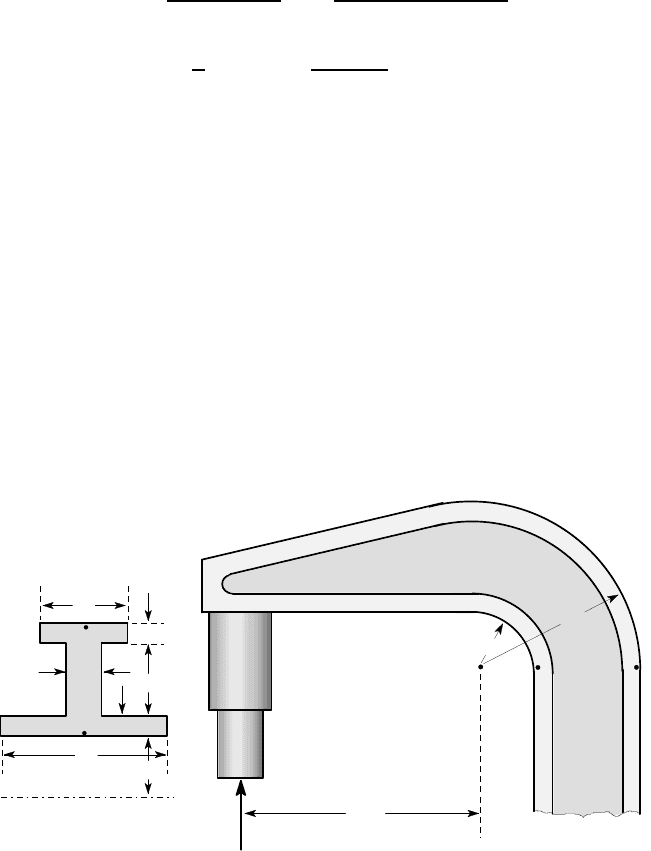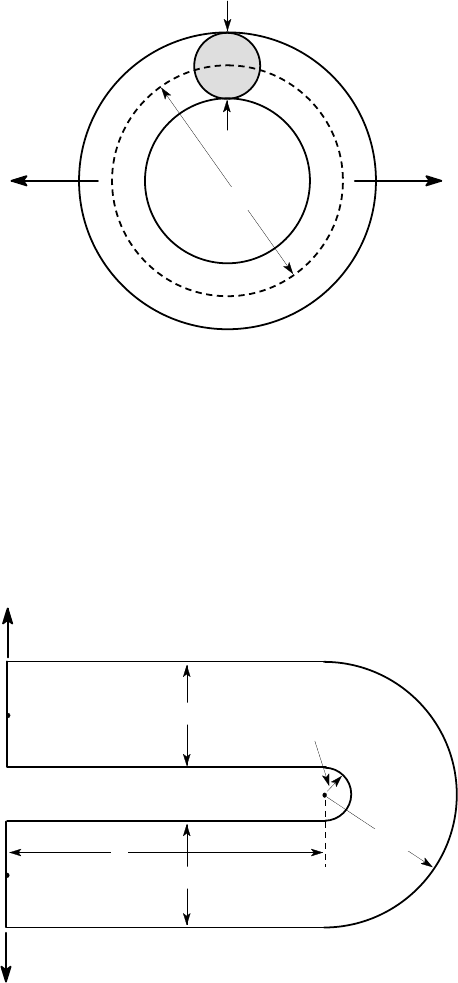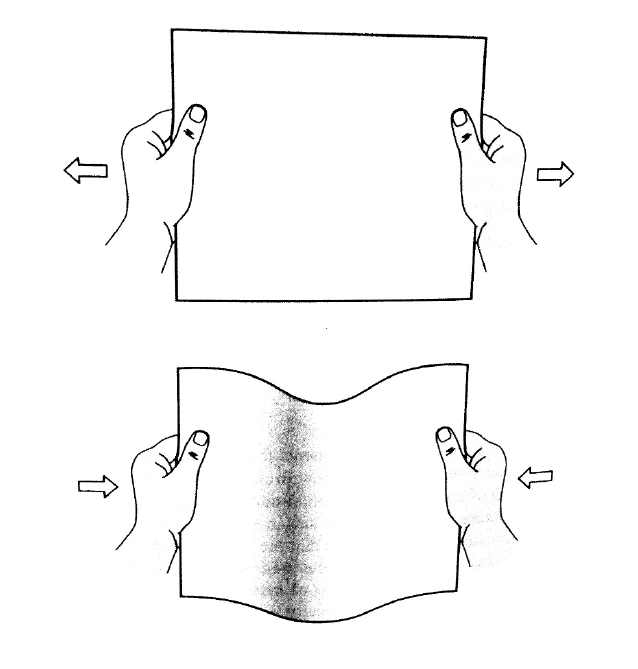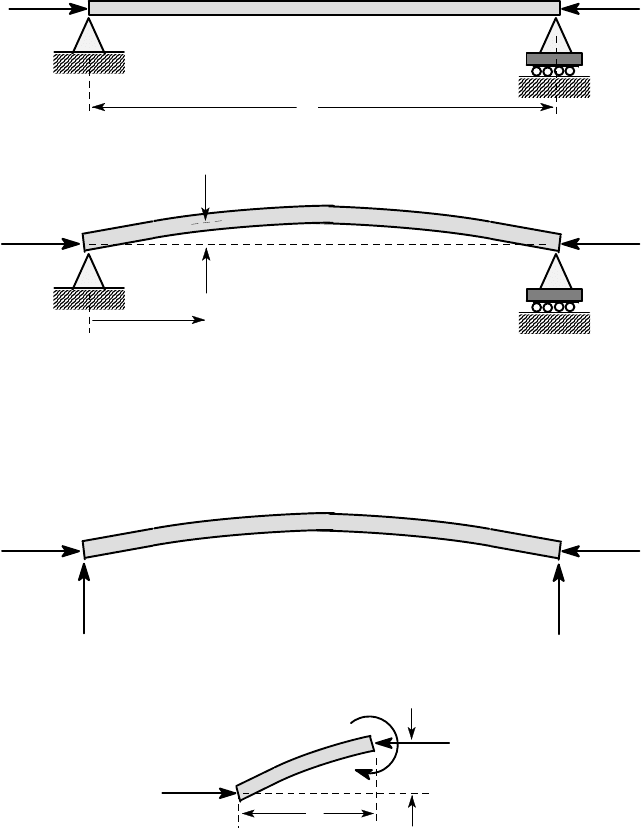Barber J.R. Intermediate Mechanics of Materials
Подождите немного. Документ загружается.


Problems 505
Further reading
A.P. Boresi, R.J. Schmidt, and O.M. Sidebottom (1993), Advanced Mechanics of
Materials, John Wiley, New York, 5th edn., Chapter 9.
R.D. Cook and W.C. Young (1985) Advanced Mechanics of Materials, Macmillan,
New York, Chapter 10.
Problems
11.1. Figure P11.1 shows a curved bar of solid circular cross section, with diameter
30 mm. The axis of the bar describes an arc with a radius 40 mm and the bar is loaded
by a bending moment of 300 Nm. Find the maximum tensile stress. What would be
the percentage error involved in using the elementary bending equation
σ
=My/I?
300 Nm
300 Nm
O
40 mm
O
40 mm
30 mm
Figure P11.1
11.2. Find the maximum bending moment that can be transmitted by the curved beam
of Figure P11.1 if the allowable tensile stress in the material is
σ
all
=120 MPa.
11.3. The elementary bending theory predicts that the ends of an initially straight
beam of length L will experience a relative rotation
∆φ
=
ML
EI
,
when subjected to a bending moment M [see equation (3.9)].
Use this result to estimate the relative rotation of the ends of the curved beam
of Figure 11.5, assuming that the ‘length’ of the beam is the mean length, L = ¯r
∆θ
,
where
∆θ
is the subtended angle (in radians). Repeat the estimate using L = ˆr
∆θ
.
Comment on your results.

506 11 Curved Beams
11.4. Figure P11.4 shows a U-shaped curved beam with a T-shaped cross section,
loaded by two opposed forces of magnitude 500 lb. Find the maximum circumferen-
tial stress
σ
max
θθ
.
O
0.25 in
500 lb
500 lb
5 in
1 in
3.5 in
0.25 in
0.25 in
1.9 in
1 in
Figure P11.4
11.5. The crane hook in Figure P11.5 is loaded by a force of 8000 lb. Find the cir-
cumferential stress at the point A, where the hook has the trapezoidal section shown
with a= 1 in., b = 4 in., c =2 in., d = 1 in.
8000 lb
8000 lb
4 in
1 in
O
A
B
O
A
B
a
d
c
b
Figure P11.5

Problems 507
You may use without proof the following results for the trapezoidal section:-
A =
(c + d)(b −a)
2
; ¯r =
(2a + b)c + (a + 2b)d
3(c + d)
;
A
ˆr
= (d −c) +
(bc −ad)
(b −c)
ln(b/a) .
11.6. Use integration to derive the expressions for A, ¯r,A/ˆr for the trapezoidal section
given in Problem 11.5.
11.7.* In a curved beam, the stress concentrating effect of the inner radius can be
reduced by making the thickness there larger than that at the outer radius. This is
the rationale for using the trapezoidal section in Figure P11.5. If the ratio between
outer and inner radii is b/a = 2, find the ratio c/d for the trapezoidal section, if the
circumferential stresses at the inner and outer radii are to be equal and opposite. The
results given in Problem 11.5 may be used without proof.
11.8. Figure P11.8 shows part of the frame of a press. Find the maximum tensile
stress at A, when a vertical load of 20 tons is applied as shown.
c
L
7
4
2.25
2.25
19
A
B
8.5
10
O
A
B
20 tons
20
7
22.5
Section A −B
all dimensions in inches
Figure P11.8

508 11 Curved Beams
11.9. The C-clamp of Figure P11.9 is manufactured from a steel with a tensile yield
stress S
Y
= 380 MPa. The frame has the T-section shown. Find the maximum clamp-
ing force P, if there is to be a factor of safety of 2.5 against yielding at the point
A.
O
P
P
A
7 R
42
c
L
2
2
12
7
14
all dimensions in mm
Figure P11.9
11.10. Figure P11.10 shows a circular ring of mean diameter 350 mm and circular
cross section of diameter 100 mm, loaded by equal and opposite 50 kN forces. Find
the maximum stress in the ring.
Method: This indeterminate problem is similar to that of Example 3.16, except
that we need to use equation (11.16) to replace the integrand in (3.110).
Use Castigliano’s second theorem to resolve the indeterminacy and hence find the
maximum bending moment. Then use the results of §11.1 to determine the maximum
tensile stress.

Problems 509
100 mm
50 kN
50 kN
350 mm
Figure P11.10
11.11. The steel U-beam of Figure P11.11 has uniform 2 inch square cross section
and is loaded by two forces P, as shown.
Use equations (11.16, 3.24) to determine the total strain energy in the beam as a
function of P and hence use the method of §3.3 to determine the relative displacement
of the points A,B, when P =4000 lbs (E
steel
=30×10
6
psi).
O
P
P
A
B
0.5 R
6
2.5 R
2
2
1
all dimensions in inches
Figure P11.11
510 11 Curved Beams
11.12. A curved beam of square cross section a×a and inner radius na is loaded by
a bending moment M.
Find the maximum circumferential stress
σ
max
θθ
and the maximum radial stress
σ
max
rr
.
Sketch the variation of these quantities as functions of n. Sketch also the ratio
σ
max
rr
/
σ
max
θθ
and comment on the results.
11.13. The curved section of the beam in Figure P11.4 is loaded by a bending mo-
ment of 200 lb ft. Find the location and magnitude of the maximum radial stress
σ
max
rr
.
11.14. Find the maximum radial stress
σ
max
rr
for the U-beam of Figure P11.11 loaded
by two forces P= 4000 lbs.

12
Elastic Stability
In many design contexts, it is desirable to use components that have the minimum
weight and cost compatible with acceptable values of strength and stiffness. The
methods of the preceding chapters will often predict that the optimum design ac-
cording to this criterion is a thin-walled structure. For example, we saw in §6.5 that
closed sections are more effective at transmitting torques and that the strength and
stiffness of such sections increases with the area enclosed by the section. It follows
that the theoretical optimum torsion member for a given mass of material is a thin-
walled cylindrical tube and the strength and stiffness theoretically increase without
limit as the radius of the tube increases and the wall thickness correspondingly de-
creases [see equations (6.39, 6.40)].
Thin-walled structures can indeed be quite surprisingly strong and lightweight
— a result that is best appreciated by constructing simple structures out of paper and
testing them to destruction.
Experiment
Take a single sheet of 8
1
2
×11 (or A4) paper, roll it up into a cylindrical tube with a
small overlap on the longer edge and tape up the join with Scotch tape. Now stand
the tube vertically on a flat table and carefully rest this book on the top of the tube.
Then add another book of similar weight.
Probably you will be able to support at least two books, with a total weight ex-
ceeding 5 lbs, on this single sheet of paper.
1
However, add a bit more weight and the complete structure will collapse. The
paper will not tear and the joint will stay intact, but the walls will fold in a complex
way and no longer support the load. This collapse mode is known as elastic instability
or buckling and it places limits on the thinness of components.
1
Somehow, it seems even more surprising that with (for example) 10 sheets of paper suitably
placed, you can support 50 lbs! Try asking your non-engineering friends to guess how many
sheets of paper (and if you want to be exact, inches of tape) are needed to support a 5 lb
weight, 11 inches above the table and then do a demonstration.
J.R. Barber, Intermediate Mechanics of Materials, Solid Mechanics and Its Applications 175,
2nd ed., DOI 10.1007/978-94-007-0295-0_12, © Springer Science+Business Media B.V. 2011

512 12 Elastic Stability
Buckling generally only occurs when the component is loaded in compression.
This again is easily demonstrated with a sheet of paper. If you grasp two opposite
edges and apply a tensile force as shown in Figure 12.1 (a), there will be no instability
and in fact the paper is quite strong. It requires considerable strength to fracture it
in tension. However, if you try to load it in compression as in Figure 12.1 (b), it will
immediately bend out of plane and support hardly any load.
(a)
(b)
Figure 12.1: A piece of paper loaded (a) in tension and (b) in compression
12.1 Uniform beam in compression
A simple system that exhibits this behaviour is the uniform beam of Figure 12.2 (a)
loaded by a compressive axial force. A straight beam loaded purely in compression
is sometimes referred to as a column. We suppose that the beam is simply-supported
at its ends, z = 0,L, and that the force P is sufficient to cause the beam to deform
into the buckled shape shown in Figure 12.2 (b), in which the lateral deflection is
described by an as yet unknown function u(z).

12.1 Uniform beam in compression 513
(a)
P
P
L
(b)
P
P
z
u(z)
Figure 12.2: (a) Simply-supported beam loaded in compression; (b) deformed shape
In general, we anticipate reaction forces R
1
,R
2
at the simple supports, as shown
in the free-body diagram of Figure 12.3 (a), but by taking moments about the ends,
A,B, respectively, it can be shown that these reactions must both be zero.
(a)
P
P
A
B
R
2
R
1
(b)
P
P
u(z)
z
M(z)
Figure 12.3: Free-body diagram of (a) the whole beam and (b) a segment of length z
at one end
Figure 12.3 (b) shows a free-body diagram for a segment of the beam of length z
and by taking moments about one end of this segment, we conclude that the bending
moment M is given by
M = Pu . (12.1)

514 12 Elastic Stability
It follows that the displacement u must satisfy the equation
EI
d
2
u
dz
2
= −M = −Pu , (12.2)
from equation (1.17), and hence
d
2
u
dz
2
+
Pu
EI
= 0 . (12.3)
This is a homogeneous ordinary differential equation whose solution can be
shown by substitution to be
u = Acos
λ
z + Bsin
λ
z , (12.4)
where
λ
=
r
P
EI
(12.5)
and A,B are arbitrary constants to be determined from the boundary conditions
u = 0 ; z = 0 (12.6)
u = 0 ; z = L . (12.7)
Substituting (12.4) into (12.6, 12.7), we obtain
A = 0 (12.8)
Bsin
λ
L = 0 . (12.9)
Clearly this problem has the trivial solution A =B =0, corresponding to the case
where u(z) = 0 for all z. In other words, the beam transmits the compressive force
whilst remaining undeformed.
However, if
sin
λ
L = 0 , (12.10)
i.e. if
λ
L =
π
, 2
π
, 3
π
, ..., (12.11)
the boundary conditions are satisfied for non-zero B. Indeed, in this case, B can take
any value. This defines a neutrally stable solution. The beam can adopt any one of a
continuous series of equilibrium configurations corresponding to different values of
the constant, B.
A simple system that exhibits neutral stability is the ball resting on a horizontal
surface, as shown in Figure 12.4 (a). The ball can be placed at any point on the
surface and it will remain there in equilibrium. By contrast, if the surface is concave,
as in Figure 12.4 (b), there is only one position of equilibrium (at the lowest point)
and it is stable, because the ball will roll back if it is displaced from the equilibrium
position. If instead the surface is convex, as in Figure 12.4 (c), there is again a single
equilibrium position, but it is unstable because an arbitrarily small displacement will
generate forces tending to accelerate the ball away from the equilibrium position.
